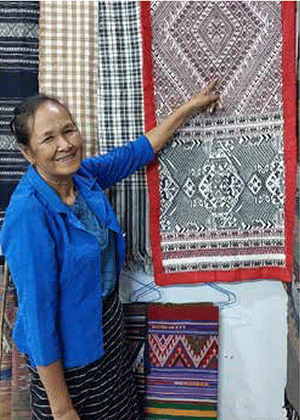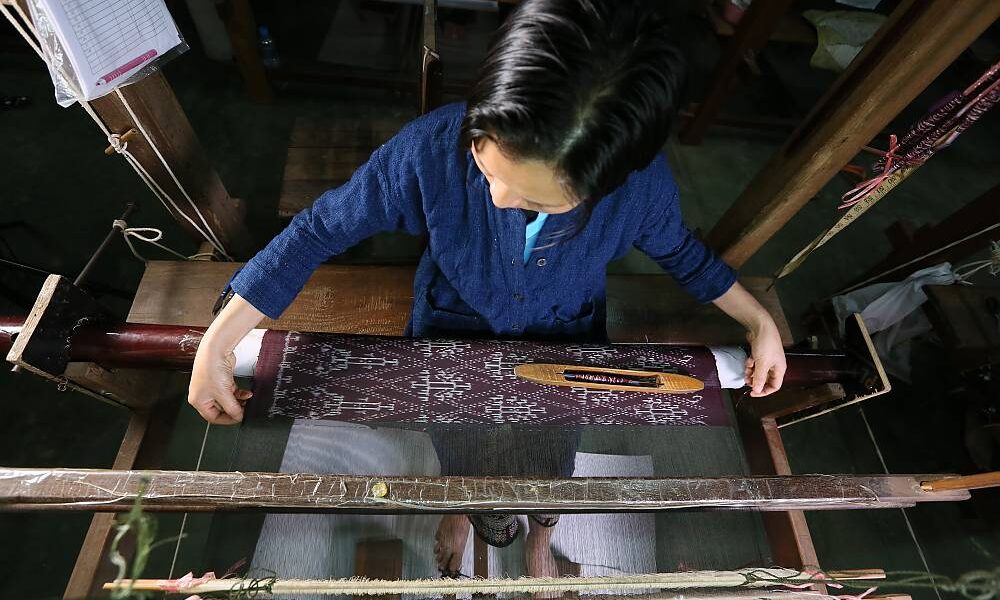The Intricate Art of Lue Weaving: Preserving Tradition and Culture
Source: Vientiane Times
The marvelous arts and tangible culture of Lue weavers are reflected in the intricate textiles they produce, based on the skills handed down by successive generations of women.
Mrs No, 70, an expert in weaving in the style of the Lue tribe, lives in Viengkham village in La district, Oudomxay province, and has been weaving since she was a young girl.
“I learned how to weave textiles, including the traditional long skirt (sinh) worn by Lao women, from my mother and her friends when I was young, and have done this work for the past 50 years. They passed on their weaving skills to me and their daughters, who wanted to be able to weave textiles the same as them,” she said.

Viengkham village is well-known for textiles made by the Lue tribe and is home to many skilled weavers and handicraft makers.
Mrs No is one of several expert weavers who make textiles in the Lue style. The Trade Promotion Department of the Ministry of Industry and Commerce has approved her weavings under the “One District, One Product” scheme and she makes several items, including sinh and other types of fabric.
She said the Lue tribe has its own techniques for designing and weaving textiles which have been handed down over the generations and been carefully preserved.
“I have used and conserved the legacy of my mother and her forebears, who created the naga motif a very long time ago. The techniques and process of producing the fabrics are still alive and will be passed on to successive generations of women,” she said.
She said Lue women have a saying “weaving cloth, weaving nagas” and it is generally recognized that incorporation of the naga motif into woven textiles is a sign of respect for past generations and the nagas themselves, believing that nagas are sacred beings.
“The first weaving pattern my mother taught me was the naga motif. There are many stylized forms but the one that is unique to the Lue tribe in Oudomxay province is the bent head of a naga (Nak Hua Khor),” she said.
She explained that there are several naga designs, involving rearing heads and raised crests. Some have bent tails while other weavers incorporate a pair of nagas. But whatever the design, it is thought that the naga motif protects the wearer of the garment.
“We feel secure and confident when wearing something with a naga motif,” she said. Mrs No said her mother taught her to raise silkworms, weave, and thread and dye cloth using tree bark. When asked what was the most difficult process, she replied that nothing was difficult because she enjoys all aspects of weaving. She is able to weave without watching the pattern as it takes shape, as she has so many years of experience.
“I enjoy making textiles every day as it brings me a lot of happiness. I never get bored with it. Sometimes I forget to have lunch at the usual time because some of the pieces I weave are really beautiful and I so enjoy making them.”

Mrs No said the most difficult part is designing and preparing patterns. It can take up to two months to prepare some patterns, and a lot of small pieces of bamboo are needed to create some designs. Textiles with naga motifs are used as wall hangings or bed covers and are very popular in Laos. There are many kinds of naga motifs, but the most common is Nak Hua Khor.
“The Lue tribe in Oudomxay province always recognize Nak Hua Khor when they see it. It is their distinctive style and is very popular but is difficult to weave so these textiles are quite expensive,” Mrs No said. The United Nations Educational, Scientific and Cultural Organisation (UNESCO) inscribed the naga weaving motif as a form of Intangible Cultural Heritage of Humanity on December 6, 2023.
.gif) | .gif) |
UNESCO’s recognition of this art form reflects the cultural value of the textiles woven by the women of many of Laos’ ethnic groups, whose weaving designs have been passed down from generation to generation.
Patterns resembling the snake-like mythical beings, naga, which are enshrined in Lao folklore, are incorporated into the fabric used to make traditional skirts and are symbolic of both protection and strength.
“The naga is a mythical, serpent-like creature that lives in rivers. Lao people believe that naga are their ancestors and watch over them,” the UNESCO website states.
Mrs No added that, to show their respect, Lao people incorporate the naga motif into many different objects, the most common of which are woven textiles made on a traditional wooden loom.
.gif) | .gif) |
Lao Buddhists also pay respect to nagas at temples and in other ways associated with religion.
In 2017, UNESCO also declared the music of the khaen, a traditional Lao pipe instrument, as a form of Intangible Cultural Heritage of Humanity.
Mrs No said she was very pleased that UNESCO had recognized the naga motif as a form of Intangible Cultural Heritage of Humanity so that its importance is acknowledged worldwide.
“The Lao people should continue to preserve the legacy of their ancestors by using the naga motif, and by wearing sinh that have a naga motif we are paying respect to our forebears,” she said.
Mrs No plans to keep on teaching young people who want to become skilled weavers the same as her. “I will continue weaving the naga motif as I have always done and also use other types of animal designs in the textiles I make.”



